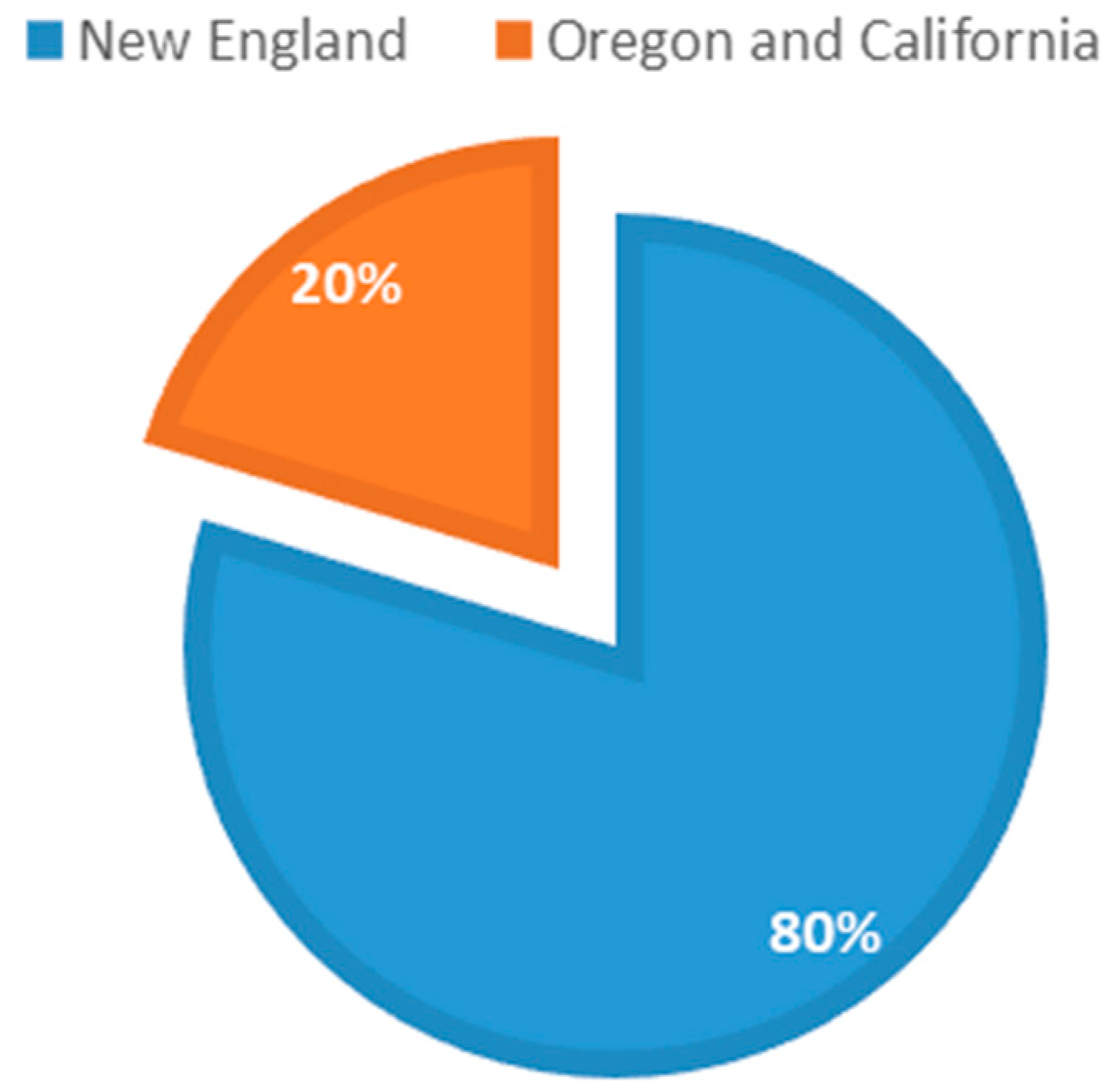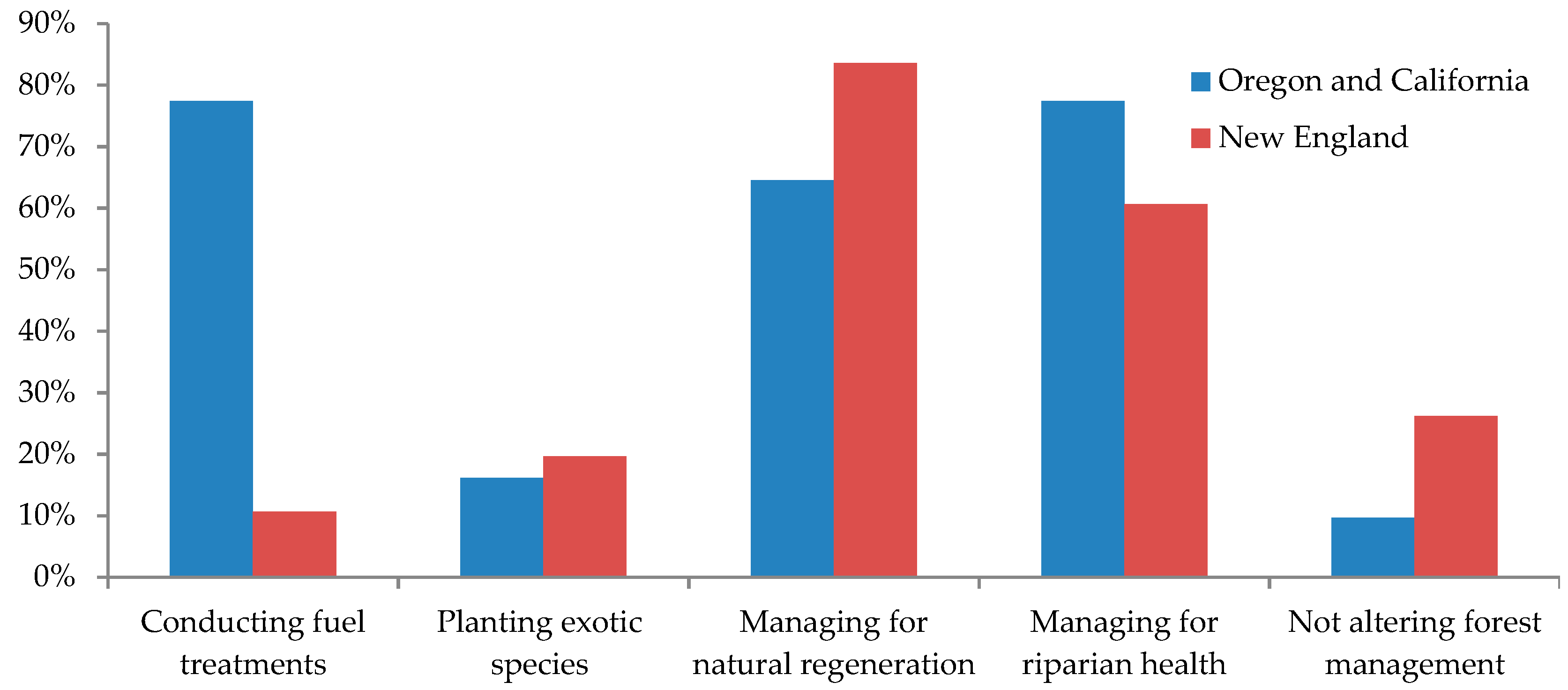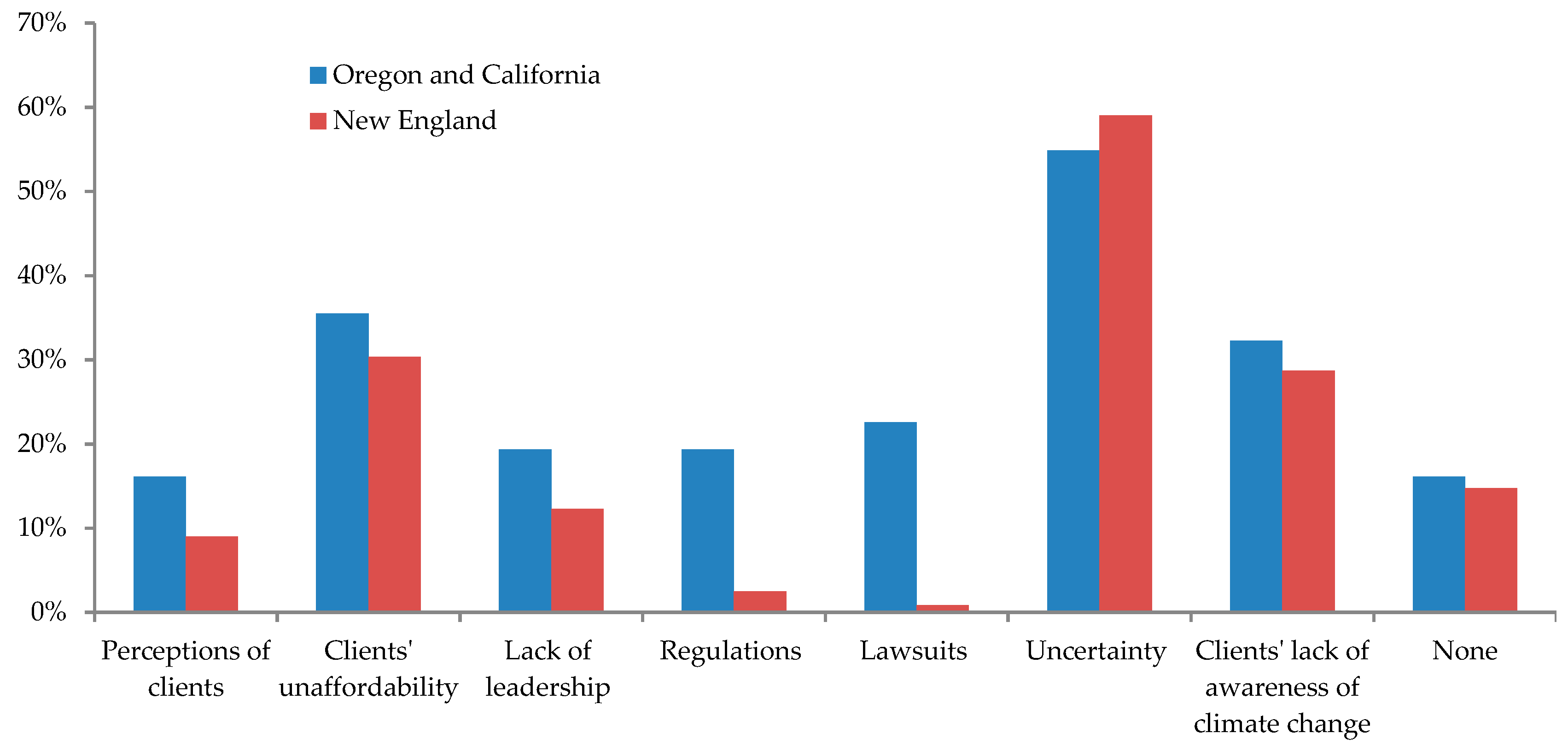Forest Management for Climate Change in New England and the Klamath Ecoregions: Motivations, Practices, and Barriers
Abstract
1. Introduction
2. Methods
3. Results and Discussion
4. Conclusions
Author Contributions
Funding
Acknowledgments
Conflicts of Interest
Appendix A
- New England
- Oregon/CA
- Federal agency
- Private consulting firm
- Conservation organization
- Private industrial forest owner
- Other (please specify)
- Private/Small owner (recoded)
- Other government (recoded)
- Small scale private non-industrial forest owners, e.g., family owned forests
- Private industrial forest owners
- National forest(s), state forest(s), or other public lands
- Conservation organization(s)
- Investment institutions
- High net-worth individual investors
- Other (please specify)
- Self (recoded)
- Writing prescriptions
- Writing regional policy documents
- Visiting sites to assess conditions and/or monitor activities
- Meeting with clients
- Planning management activities for my institution, (clients, self-owned land) (recoded)
- Other (please specify)
- Research and Monitoring (recoded)
- Timber harvest: Inventory, sales, marketing, boundaries, etc. (recoded)
- Purchased new harvest equipment (upgrade infrastructure, e.g., roads) (recoded)
- Conducted fuel treatments, (fire suppression, fire protection) (recoded)
- Planting species from outside current zone
- Planting cultivars from outside current zone
- Managing for natural regeneration
- Managing for riparian health
- I am not altering my forest management actions
- Other (please specify)
- Managing for forest health and resilience; invasive species control (recoded)
- Increasing soil water retention (recoded)
- Shifting harvest season (recoded)
- Increasing species diversity and climate adapted species (recoded)
- Provide for (current and) future generations (recoded)
- Client demand
- Maintain sustainable yield
- Maintain natural regeneration
- Awareness of changing climate
- My institution promotes or requires
- None-I do not practice climate adaptive management
- Other (please specify)
- Maintain habitat (recoded)
- Client attitudes against climate adaptive management
- Economic-client(s) cannot afford
- Lack of leadership (and staff) within my organization (recoded)
- Regulations prevent necessary action
- Lawsuits prevent necessary action
- Uncertainty about possible climate change effects (possible actions) (recoded)
- Lack of education and/or awareness of climate change from clients or public
- None—I do not practice climate adaptive management
- Other (please specify)
- Personal beliefs—I do not believe in climate change (recoded)
- No barriers (recoded)
- US Forest Service publications
- Published scientific articles
- Local or regional organizations, e.g., local timber associations, Society of American Foresters etc.
- News outlets, e.g., the local or national media
- Information provided by my institution
- Personal experience
- Local monitoring or data collection or experimentation
- Colleagues and personal networks
- Other (please specify)
- Extension office or similar (recoded)
References
- Lindner, M.; Maroschek, M.; Netherer, S.; Kremer, A.; Barbati, A.; Garcia-Gonzalo, J.; Seidl, R.; Delzon, S.; Corona, P.; Kolström, M.; et al. Climate change impacts, adaptive capacity, and vulnerability of European forest ecosystems. For. Ecol. Manag. 2010, 259, 698–709. [Google Scholar] [CrossRef]
- Turner, M.G.; Donato, D.C.; Romme, W.H. Consequences of spatial heterogeneity for ecosystem services in changing forest landscapes: Priorities for future research. Landsc. Ecol. 2013, 28, 1081–1097. [Google Scholar] [CrossRef]
- Creutzburg, M.K.; Scheller, R.M.; Lucash, M.S.; LeDuc, S.D.; Johnson, M.G. Forest management scenarios in a changing climate: Trade-offs between carbon, timber, and old forest: Trade-offs. Ecol. Appl. 2017, 27, 503–518. [Google Scholar] [CrossRef] [PubMed]
- Puettmann, K.J.; Coates, K.D.; Messier, C.C. A Critique of Silviculture: Managing for Complexity; Island Press: Washington, DC, USA, 2009; ISBN 1597261467. [Google Scholar]
- D’Amato, A.W.; Jokela, E.J.; O’Hara, K.L.; Long, J.N. Silviculture in the United States: An amazing period of change over the past 30 years. J. For. 2017, 116, 55–67. [Google Scholar] [CrossRef]
- Messier, C.C.; Puettmann, K.J.; Coates, K.D. Managing Forests as Complex Adaptive Systems: Building Resilience to the Challenge of Global Change; Earthscan from Routledge: London, UK, 2013; ISBN 9780415519779. [Google Scholar]
- Spittlehouse, D.L.; Stewart, R.B. Adaptation to climate change in forest management. BC J. Ecosyst. Manag. 2004, 4, 1–11. [Google Scholar]
- Walker, B.; Holling, C.S.; Carpenter, S.R.; Kinzig, A. Resilience, adaptability and transformability in social–ecological systems. Ecol. Soc. 2004, 9, 5. [Google Scholar] [CrossRef]
- Spies, T.A.; Giesen, T.W.; Swanson, F.J.; Franklin, J.F.; Lach, D.; Johnson, K.N. Climate change adaptation strategies for federal forests of the Pacific Northwest, USA: Ecological, policy, and socio-economic perspectives. Landsc. Ecol. 2010, 25, 1185–1199. [Google Scholar] [CrossRef]
- Kelly, E.C.; Di Tommaso, J.; Weisgrau, A. Family forest owners in the redwood region: management priorities and opportunities in a carbon market. USDA For. Serv. 2017, 258, 403–412. [Google Scholar]
- Shindler, B.; Spies, T.A.; Bolte, J.P.; Kline, J.D. Integrating ecological and social knowledge: Learning from CHANS research. Ecol. Soc. 2017, 22, art26. [Google Scholar] [CrossRef]
- Loudermilk, E.L.; Scheller, R.M.; Weisberg, P.J.; Kretchun, A. Bending the carbon curve: Fire management for carbon resilience under climate change. Landsc. Ecol. 2017, 32, 1461–1472. [Google Scholar] [CrossRef]
- Krofcheck, D.J.; Hurteau, M.D.; Scheller, R.M.; Loudermilk, E.L. Prioritizing forest fuels treatments based on the probability of high-severity fire restores adaptive capacity in Sierran forests. Glob. Chang. Biol. 2018, 24, 729–737. [Google Scholar] [CrossRef] [PubMed]
- Winter, G.; Fried, J.S. Homeowner perspectives on fire hazard, responsibility, and management strategies at the wildland-urban interface. Soc. Nat. Resour. 2000, 13, 33–49. [Google Scholar] [CrossRef]
- Ward, B.C.; Mladenoff, D.J.; Scheller, R.M. Simulating landscape-level effects of constraints to public forest regeneration harvests due to adjacent residential development in Northern Wisconsin. For. Sci. 2005, 51, 616–632. [Google Scholar]
- North, M.P.; Stephens, S.L.; Collins, B.M.; Agee, J.K.; Aplet, G.; Franklin, J.F.; Fulé, P.Z. Reform forest fire management: Agency incentives undermine policy effectiveness. Science 2015, 349, 1280–1281. [Google Scholar] [CrossRef] [PubMed]
- Janowiak, M.K.; D’Amato, A.W.; Swanston, C.W.; Iverson, L.; Thompson, F.R.; Dijak, W.D.; Matthews, S.; Peters, M.P.; Prasad, A.; Fraser, J.S.; et al. New England and northern New York forest ecosystem vulnerability assessment and synthesis: A report from the New England Climate Change Response Framework project. North. Res. Stn. 2018, 173, 1–234. [Google Scholar]
- L’Roe, A.W.; Rissman, A.R. Factors that influence working forest conservation and parcelization. Landsc. Urban Plan. 2017, 167, 14–24. [Google Scholar] [CrossRef]
- Labriole, M.M.; Luzadis, V.A. New York society of American foresters’ perceptions of climate change. J. For. 2011, 109, 89–94. [Google Scholar]
- Carlton, J.S.; Angel, J.R.; Fei, S.; Huber, M.; Koontz, T.M.; Macgowan, B.J.; Mullendore, N.D.; Babin, N.; Prokopy, L.S. State service foresters’ attitudes toward using climate and weather information when advising forest. J. For. 2014, 112, 9–14. [Google Scholar] [CrossRef]
- Lenart, M.; Jones, C. Perceptions on climate change correlate with willingness to undertake some forestry adaptation and mitigation practices. J. For. 2014, 112, 553–563. [Google Scholar] [CrossRef]
- Rodriguez-Franco, C.; Haan, T.J. Understanding climate change perceptions, attitudes, and needs of forest service resource managers. J. Sustain. For. 2015, 34, 423–444. [Google Scholar] [CrossRef]
- Wojcik, D.J.; Monroe, M.C.; Adams, D.C.; Plate, R.R. Message in a bottleneck? Attitudes and perceptions of climate change in the cooperative extension service in the southeastern United States. J. Hum. Sci. Ext. 2014, 2, 51–70. [Google Scholar]
- Morris, H.L. C.; Megalos, M.A.; Hubbard, W.G.; Boby, L.A. Climate change attitudes of southern forestry professionals: outreach implications. J. For. 2016, 114, 532–540. [Google Scholar] [CrossRef]
- Boby, L.; Megalos, M.; Hubbard, W. Southern foresters’ perceptions of climate change: Implications for educational program development. J. Ext. 2016, 54, 1–10. [Google Scholar]
- Butler, P.R.; Swanston, C.W.; Janowiak, M.K. Forest adaptation resources: Climate change tools and approaches for land managers. In Forest Adaptation Resources: Climate Change Tools and Approaches for Land Managers; Swanston, C., Janowiak, M., Eds.; USDA Foreast Service, Northern Research Station: Newtown, PA, USA, 2012; pp. 15–34. [Google Scholar]
- Janowiak, M.K.; Swanston, C.W.; Nagel, L.M.; Brandt, L.A.; Butler, P.R.; Handler, S.D.; Shannon, P.D.; Iverson, L.R.; Matthews, S.N.; Prasad, A.; et al. A practical approach for translating climate change adaptation principles into forest management actions. J. For. 2014, 112, 424–433. [Google Scholar] [CrossRef]
- Nelson, H.W.; Williamson, T.B.; Macaulay, C.; Mahony, C. Assessing the potential for forest management practitioner participation in climate change adaptation. For. Ecol. Manag. 2016, 360, 388–399. [Google Scholar] [CrossRef]
- D’Amato, A.W.; Bradford, J.B.; Fraver, S.; Palik, B.J. Forest management for mitigation and adaptation to climate change: Insights from long-term silviculture experiments. For. Ecol. Manag. 2011, 262, 803–816. [Google Scholar] [CrossRef]
- Duguma, L.A.; Minang, P.A.; Van Noordwijk, M. Climate change mitigation and adaptation in the land use sector: From complementarity to synergy. Environ. Manag. 2014, 54, 420–432. [Google Scholar] [CrossRef] [PubMed]
- Locatelli, B.; Evans, V.; Wardell, A.; Andrade, A.; Vignola, R. Forests and climate change in Latin America: Linking adaptation and mitigation. Forests 2011, 2, 431–450. [Google Scholar] [CrossRef]
- Millar, C.I.; Stephenson, N.L.; Stephens, S.L. Climate change and forest of the future: Managing in the face of uncertanity. Ecol. Appl. 2007, 17, 2145–2151. [Google Scholar] [CrossRef] [PubMed]
- Williamson, T.B.; Nelson, H.W. Barriers to enhanced and integrated climate change adaptation and mitigation in Canadian forest management. Can. J. For. Res. 2017, 47, 1567–1576. [Google Scholar] [CrossRef]
- Swanston, C.; Janowiak, M.K.; Iverson, L.R. Ecosystem Vulnerability Assessment and Synthesis: A Report from the Climate Change Response Framework Project in Northern Wisconsin; USDA Foreast Service, Northern Research Station: Newtown, PA, USA, 2011.
- Swanston, C.; Janowiak, M. Forest Adaptation Resources: Climate Change Tools and Approaches for Land Managers; USDA Foreast Service, Northern Research Station: Newtown, PA, USA, 2012.
- Halofsky, J.; Peterson, D.; Halofsky, J.E.; Peterson, D.L. Climate change vulnerabilities and adaptation options for forest vegetation management in the northwestern USA. Atmosphere 2016, 7, 46. [Google Scholar] [CrossRef]
- Serra-Diaz, J.M.; Maxwell, C.; Lucash, M.S.; Scheller, R.M.; Laflower, D.M.; Miller, A.D.; Tepley, A.J.; Epstein, H.E.; Anderson-Teixeira, K.J.; Thompson, J.R. Disequilibrium of fire-prone forests sets the stage for a rapid decline in conifer dominance during the 21st century. Sci. Rep. 2018, 8, 6749. [Google Scholar] [CrossRef] [PubMed]
- Markowski-Lindsay, M.; Stevens, T.; Kittredge, D.B.; Butler, B.J.; Catanzaro, P.; Damery, D. Family forest owner preferences for biomass harvesting in Massachusetts. For. Policy Econ. 2012, 14, 127–135. [Google Scholar] [CrossRef]
- Greene, W.W.H. Econometric Analysis; Pearson Education Limited: Essex, UK, 2012; ISBN 9780131395381. [Google Scholar]
- Baltas, G.; Doyle, P. Random utility models in marketing research: A survey. J. Bus. Res. 2001, 51, 115–125. [Google Scholar] [CrossRef]
- Gan, J.; Jarrett, A.; Gaither, C.J. Wildfire risk adaptation: propensity of forestland owners to purchase wildfire insurance in the southern United States. Can. J. For. Res. 2014, 44, 1376–1382. [Google Scholar] [CrossRef]
- Holmes, T.P.; McNulty, S.; Vose, J.M. A conceptual framework for adaptive forest management under climate change. In Climate Change Adaption and Mitigation Management Options: A Guide for Natural Resource Managers in Southern Forest Ecosystems; CRC Press-Taylor and Francis: Boca Raton, FL, USA, 2014; pp. 45–60. [Google Scholar]
- Yousefpour, R.; Temperli, C.; Jacobsen, J.B.; Thorsen, B.J.; Meilby, H.; Lexer, M.J.; Lindner, M.; Bugmann, H.; Borges, J.G.; Palma, J.H.N.; et al. A framework for modeling adaptive forest management and decision making under climate change. Ecol. Soc. 2017, 22, 40. [Google Scholar] [CrossRef]
- Brunette, M.; Bourke, R.; Hanewinkel, M.; Yousefpour, R. Adaptation to climate change in forestry: A multiple correspondence analysis (MCA). Forests 2018, 9, 20. [Google Scholar] [CrossRef]




| Variable | Description | Mean (S.D.) |
|---|---|---|
| Alter | Binary variable, 1 if the respondent alter forest management actions to adapt to climate change, 0 otherwise | 0.77 (0.42) |
| Landowner | Categorical variable,1 if the respondent is a private landowner, 0 otherwise | 0.16 (0.36) |
| Location | Binary variable, 1 if the respondent is from New England, 0 if the primary location of the respondent is Oregon/California | 0.78 (0.41) |
| Maintain_natreg | Binary variable, 1 if the primary reason for managing for climate change is to maintain natural regeneration, 0 otherwise | 0.71 (0.46) |
| AwareCC | Binary variable, 1 if the primary reason for managing for climate change is the awareness of climate change, 0 otherwise | 0.63 (0.48) |
| Economics | Binary variable, 1 if the primary barrier that the respondent has encountered to conduct climate adaptive management is economics i.e., client(s) cannot afford, 0 otherwise | 0.31 (0.46) |
| Lack_education | Binary variable, 1 if the primary barrier that the respondent has encountered to conduct climate adaptive management is lack of education and/or awareness of climate change among clients, 0 otherwise | 0.29 (0.46) |
| Local_source | Binary variable, 1 if the respondent’s primary source of information about climate adaptive management is local organization, local media and local monitoring or data collection, 0 otherwise | 0.69 (0.46) |
| Factors | Coefficient (Robust Standard Error) | Odds Ratio | Marginal Effects at the Mean Value |
|---|---|---|---|
| Landowner | −0.70 (0.56) | 0.50 | −0.07 |
| location | −2.30 (0.75) a | 0.10 | −0.24 |
| Motivating factors for conducting climate adaptive management | |||
| Maintain natural regeneration | 1.15 (0.47) a | 3.17 | 0.12 |
| Awareness of changing climate | 1.30 (0.46) a | 3.65 | 0.14 |
| Barriers that managers have encountered in conducting climate adaptive management | |||
| Economics-client(s) cannot afford | 1.63 (0.73) a | 5.12 | 0.17 |
| Lack of education among clients | 1.65 (0.86) b | 5.23 | 0.17 |
| Primary source of information about climate adaptive management | |||
| Local sources of information about climate change | 0.61 (0.55) | 1.84 | 0.06 |
| Specification tests | |||
| Hat-square from linktest | −0.08 (p = 0.29) | ||
| Hosmer and Lemeshow’s goodness of fit | 4.30 (p = 0.83) | ||
© 2018 by the authors. Licensee MDPI, Basel, Switzerland. This article is an open access article distributed under the terms and conditions of the Creative Commons Attribution (CC BY) license (http://creativecommons.org/licenses/by/4.0/).
Share and Cite
Scheller, R.M.; Parajuli, R. Forest Management for Climate Change in New England and the Klamath Ecoregions: Motivations, Practices, and Barriers. Forests 2018, 9, 626. https://doi.org/10.3390/f9100626
Scheller RM, Parajuli R. Forest Management for Climate Change in New England and the Klamath Ecoregions: Motivations, Practices, and Barriers. Forests. 2018; 9(10):626. https://doi.org/10.3390/f9100626
Chicago/Turabian StyleScheller, Robert M., and Rajan Parajuli. 2018. "Forest Management for Climate Change in New England and the Klamath Ecoregions: Motivations, Practices, and Barriers" Forests 9, no. 10: 626. https://doi.org/10.3390/f9100626
APA StyleScheller, R. M., & Parajuli, R. (2018). Forest Management for Climate Change in New England and the Klamath Ecoregions: Motivations, Practices, and Barriers. Forests, 9(10), 626. https://doi.org/10.3390/f9100626






